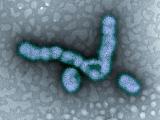Jan 21, 2010 (CIDRAP News) – In one of the first large serologic studies of pandemic H1N1 infection, British researchers found that in areas hit hard during the first wave, one in three children were infected by the virus, ten times higher than surveillance estimates.
Serologic studies, such as this report by scientists from England's Health Protection Agency (HPA) published today in The Lancet, are needed to help public health officials gauge the true burden of disease. Flu surveillance captures only the number of people who seek medical care for illnesses, missing asymptomatic or mild infections.
Public health officials also use serologic studies to assess the effectiveness of vaccination and other strategies and to fine-tune their modeling assumptions for future flu outbreaks.
Researchers compared baseline antibodies to the pandemic H1N1 virus collected in 2008 through routine HPA collections in eight of England's nine regions with those collected in August and September 2009 after the first pandemic wave, which occurred in earlier in the summer. They also obtained samples from patients who had confirmed pandemic H1N1 infections.
The investigation included 1,403 serum samples taken before the pandemic and 1,954 samples obtained in August and September.
The group used hemagglutinin inhibition and microneutralization assays to detect antibody response. They assumed that a hemagglutinin inhibition titer of around 1:32 reflected protection, though researchers don't know the threshold of protection for the new virus. The investigators assumed that infected patients took 3 weeks to seroconvert.
Surveillance data included in the study was the same information that the HPA gathered and reported in its weekly pandemic flu estimates.
Their analysis found that different regions were hit harder by the virus, with London and the West Midlands showing the greatest burden.
They found a significant increase between baseline and September in all age-groups younger than 25, with the highest incidence in the 5- to 14-year-old age-group. Serologic evidence suggests that as many as one in three children under 15 and one in five of those ages 15 to 24 were infected during the first pandemic wave
"This finding is consistent with the high level of susceptibility in children and the increased potential for transmission that occurs within schools," they wrote.
Findings suggested that a substantial proportion of older adults had preexisting immunity to the pandemic virus, which experts say could result from previous exposure to antigenically similar flu viruses.
The group projected that about one in four adults age 65 or older should be protected, based on the hemagglutinin inhibition titer cutoff. However, they wrote that as many as two in three of this age-group may be protected, if the presence of detectable microneutralization antibody is used.
Researchers concluded that their findings provide valuable insights into pandemic H1N1 epidemiology and how it relates to baseline immunity. They added that their results should be useful to other countries that experienced a similar first wave.
Study findings, plus disease incidence modeling, suggests that the late October launch of the pandemic vaccine did little to mitigate the second wave of infections in the fall, they wrote.
They suggest that the results also highlight the role of children in flu transmission and that extending seasonal flu vaccination to this age-group has the potential to protect young people and help provide herd immunity to the larger population.
Miller E, Hoschler K, Hardelid P, et al. Incidence of 2009 pandemic influenza A H1N1 infection in England: a cross-sectional serological study. Lancet 2010;Jan 21 Early online publication [Abstract]
















